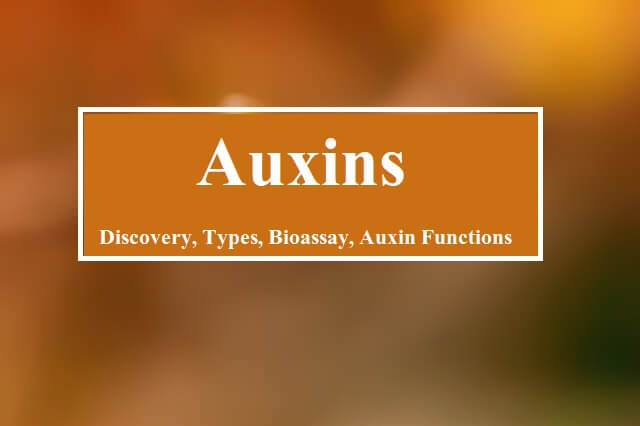Here we are going to discuss “Auxins: Overview, Discovery, Types of auxins, Bioassay, Auxin Functions” Among the growth hormones Auxin was the first to be discovered. Auxins are weakly acidic plant growth hormones capable of promoting cell elongation in shoots. Auxin (GK. auxeine = to grow). Have an unsaturated ring structure.
Auxins help in the elongation of roots and shoots in the plants. However, the concentration of Auxin for the root and shoot development is different. The optimum concentration in stem is 10 is ppm is and the optimum concentration for roots is 0.0001 ppm. higher concentration of auxins inhibits the growth in plants. Auxins also work as an inhibitor when its concentration is less than 100 ppm.
Discovery of Auxins
1. Julius Von Sachs Experiment
Julius Von Sachs was the first person who indicates the presence of organ forming substances in plants.
2. Charles Darwin Experiment
The first plant growth hormone came from the work of Darwin and Darwin. “Power of movements in plants” is a book of Darwin, in which Darwin and his son found that bending moments of coleoptile of grass (Canary Grass) was due to exposure of coleoptile tip to unilateral light. The botanical name of Canary grass is Phalasis canariensis.
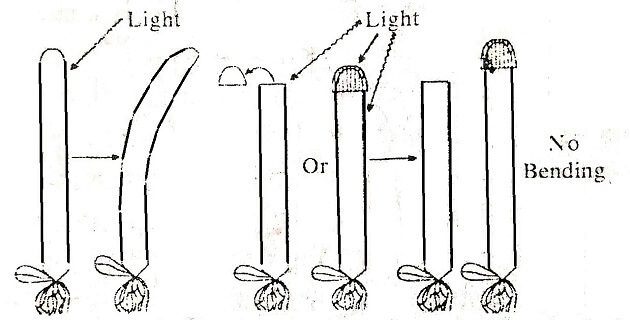
3. Boysen Jensen Experiment
Boysen Jensen during their work from 1910-1913 found that the tip produces a chemical. That chemical later named “Auxin”
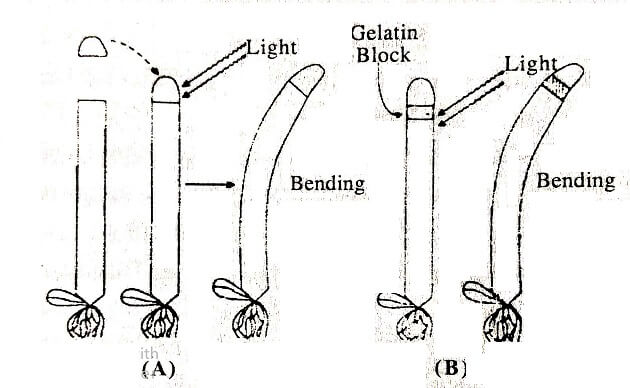
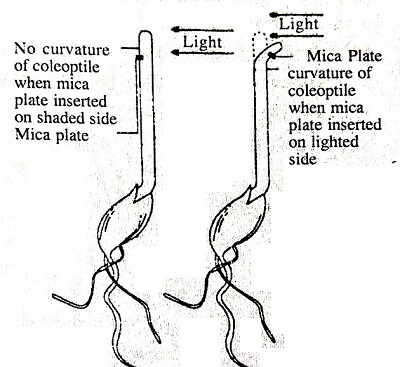
4. Paal Experiment
Paal removed the coleoptile tip and replaced it asymmetrically. Paal was trying to find a curvature during his work from 1914 -1919.
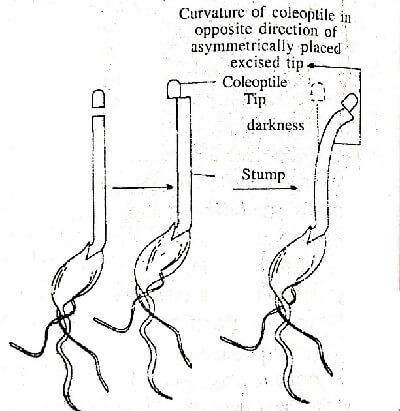
5. F.W. Went Experiment
WENT collected Auxins from coleoptile tip of Avena in 1928.WENT also developed test for bioassay of Auxins
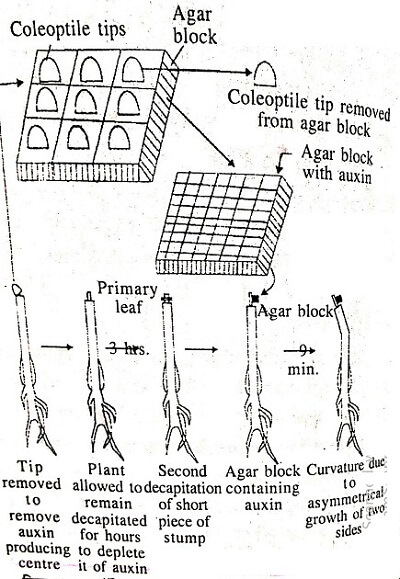
F.W. Went also performed an experiment to measure the quantity of Auxin. He choosen Oat coleoptile for this. He placed two Agar blocks equally on a cutted coleoptile tip and reached to the result that 65% Auxins are produced in part of coleoptile which is exposed for sunlight whereas only 35% auxins produced on the side of coleoptile where light is not exposed.
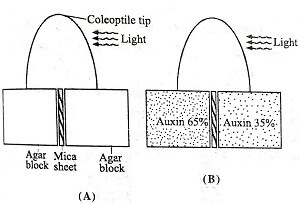
Auxins Movement
Auxins Show polar moment which is moved from Apex to base in the plant stem. This type of movement is called basipetal movement. But in case of root, the movement of auxins is acropetal. In the acropetal movement, auxins moved from root tip towards the shoot. By diffusion process, auxins move slowly from Cell to cell and not through the vascular tissues.
Types of Auxins
There are two major categories of auxins
1. Natural auxins and 2. synthetic auxins
1. Natural Auxins
Naturally occurring auxins in plants called natural Auxins. These are phytohormones. Best known natural occurring auxin is indole 3 acetic acid or heteroauxin. Indole 3 acetic acid found in all types of Plants and Fungi. Amino acid Tryptophan is responsible for the synthesis of natural occurring auxins
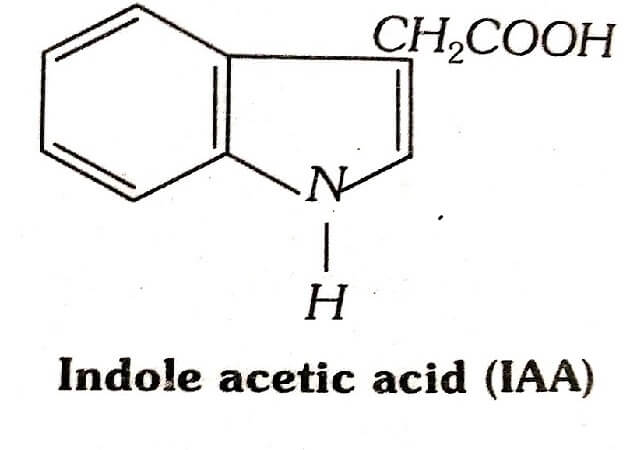
Kogl and Haagen-Smith first isolated naturally occurring auxin from human urine in 1931. isolated auxins were identified as Auxenotriolic acid (C18 H32 O5). Later Kogl and Haagen-Smith and Erxleben obtained another auxin in 1934. This isolated was called Auxin B (Auxenolonic Acid), the chemical formula of Auxenolonic Acid is C18 H30 O4. Auxenolonic Acid was isolated from common germ oil which was extracted from germinating corn seeds.
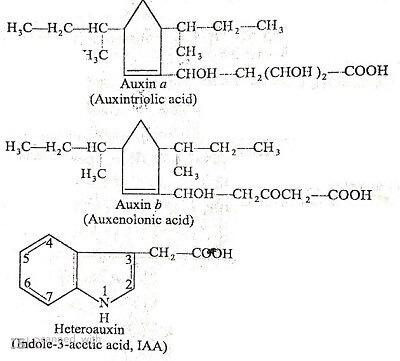
Natural auxins are synthesized in shoot Apices, leaf primordia, developing seeds, developing buds, developing embryos. In other words, we can say that natural auxins are synthesized in physiological active parts of plants.
2. Synthetic Auxins
Synthetic auxins are synthetic compounds which cause various physiological responses. Physiological responses are common to indole 3 acetic acid. These are some Names of synthetic auxins
- 2, 4-D (2,4-dichlorophenoxy acetic acid)
- 2,4,5-T (2,4,5-trichlorophenoxy acetic acid)
- IBA (Indole 3 Butyric acid)
- NAA (naphthalene acetic acid)
- PAA (Phenyl acetic acid)
- IPA (indole 3 Propionic Acid)
Note – IBA (Indole 3 Butyric acid) is both natural and synthetic auxin. 2, 4-D (2,4-dichlorophenoxy acetic acid) is weedicide.
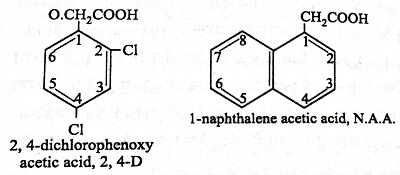
Antiauxins
Antiauxins are those compounds which inhibit the action or effects of auxin.
- PCIB – p- chlorophenoxy isobutyric acid
- TIBA – 2,3,5-tri iodobenzoic acid
Bioassay of Auxins
Bioassay is the testing of biological activity of a substance by using living material.
- Avena coleoptile curvature test- In 1928 Avena coleoptile curvature test is carried out by F.W. Went. He demonstrated the effect of organs in plants by performing some experiment with the Oat coleoptile.
- Pea Stem curvature test– In 1934, Pea Stem curvature test is also carried out by F.W. Went.
- Root growth inhibition test ( cress root inhibition test)
Functions of Auxins

MCQs on auxin

These are some important frequently asked questions during competitive exams. read carefully.

What is the role of auxins in plants?
Auxins promote cell elongation, inhibits the growth of lateral Buds, promote the growth of apical buds, Inhibits the Premature fall of fruits, Weed control, promotes root formation in cutting stems, induces Parthenocarpy, increase cotton production, Delay the flowering in lettuce, induces differentiation of xylem and phloem cells, Auxins supports femaleness in plants, auxins induced cell divisions around the injured area. induces Nodule formation, increases the rate of respiration indirectly.
How are Auxins used commercially?
Auxins used commercially to promote the growth of plants, to reduce leaf and fruits falls, to controls weeds, to produce parthenocarpic fruits, for the formation of roots in cutting end of stems, to increase the production of cotton etc.
Who discovered auxin?
Auxins were discovered by Went in 1928 from coleoptile tip of Avena. but the Existence of first plant growth hormone was discovered by Darwin in 1881. Boysen- Jenson (1910, 1913) found that the tip produces a chemical which was later named as “Auxin”. Auxins was first collected by Went in 1928.
What are the 5 plant hormones?
These are 5 Plant Hormones
1. AUXIN, 2. GIBBERELLIN, 3. CYTOKININ, 4. ETHYLENE 5. ABSCISIC ACID.
What are the types of auxin?
Auxins are of two types
1. Natural Auxins- Indole 3 acetic acid
2. Synthetic Auxins- IBA, IPA, NAA, PAA etc.
Where auxin is synthesized?
Auxins are synthesized in meristematic regions of the shoots of plants.
How is auxin transported?
Auxins Show polar moment which is moved from Apex to base in the plant stem. This type of movement is called basipetal movement. But in case of root, the movement of auxins is acropetal. In the acropetal movement, auxins moved from root tip towards the shoot. By diffusion process, auxins move slowly from Cell to Cell.
What are synthetic auxins?
Synthetic auxins are those chemical compounds that are not occurs naturally in plants. these chemical compounds work as natural auxins (Indole 3 Acetic Acid). Synthetic auxins artificially made by the human such as I) 2, 4-D, II) 2,4,5-T III) IBA IV) NAA, V) PAA, VI) IPA.
What are auxins used for?
growth of plants, to reduce premature leaf and fruits falls, for weed control, to induce parthenocarpy, for the formation of roots in cutting end of branches, to increase the yield of cotton.
What is the main function of auxin?
Cell elongation, Parthenocarpy, Roots formation in cutting stems, weed controls are the main functions of Auxins.
What do you mean by natural auxin?
Natural Auxins are synthesized in tips of roots and shoots of plants. these are naturally occurring plant growth hormones. Indole 3 Acetic Acid is a very popular natural auxin.
Also Read-
- Cytokinins: Overview, Discovery, Types, Bioassay And Functions
- Abscisic Acid (ABA): Overview, Discovery, Types, Bioassay, Functions
- Factors Affecting Plant Growth: External Factors And Internal Factors
- Plant Hormones: Growth Regulators – Promoters And Inhibitors In Details
Here we have discussed “Auxin: Overview, Discovery, Types of auxins, Bioassay, Auxin Functions” we hope you like this article. if you have any query or suggestion, please leave a comment on the email. or contact us from contact us page.
Follow our official groups on Telegram, Whatsapp and Facebook

